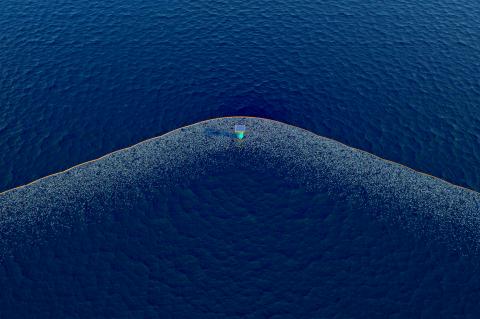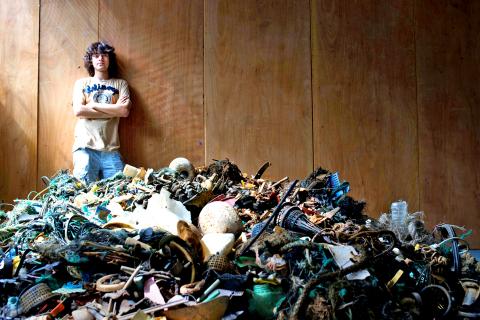Dutch student Boyan Slat is only 19 years old, but he already has 100 people working on his revolutionary plan to scoop thousands of tonnes of damaging plastics from the oceans.
The world’s “plastic soup,” much of it swirling around in five main gyres or rotating oceanic currents, costs billions of euros to the fishing and tourism sectors every year.
Estimates differ as to how much of the waste is in our oceans, ranging from half a million to millions of tonnes.

Photo: AFP
The scourge kills marine life, entering the food chain when sea creatures ingest it, as well as ensnaring dolphins and whales.
While most ideas for attacking the plastic plague involve boats criss-crossing the oceans to scoop up the waste, Slat came up with a remarkably practical way to help solve the problem: harnessing the power of sea currents to trap the “soup.”
“Why go after the plastic if the plastic can come to you?” the aeronautical engineering student told AFP.

Photo: AFP
‘SOUP TRAP’
His design calls for two vast floating arms, 50 km long each, in the form of a “V”, anchored to the ocean floor.
Curtains, ironically made from super-strong plastic, hang from the arms, dangling around three meters below the surface.
Ocean currents will force the waste into the “V” and to a cylindrical platform 11 meters in diameter floating at the end which can store up to 3,000 cubic meters of plastic (more than an Olympic swimming pool ) for eventual collection by a ship. A solar-powered conveyor belt will take the largest chunks of plastic to and from a shredder so that it will fit in the cylinder.
The blue-eyed, shaggy-haired Slat, who still lives at home with his parents, says he got his idea while scuba-diving in Greece. “I saw more plastics than fish under the water,” he recalled.
He publicly presented it for the first time at the end of 2012, hardly daring to dream it would become reality. Today, he has put his studies on hold and 100 people around the world are working for him, several of them full time.
‘FASTER, CHEAPER’
Following a year of feasibility studies and a certain amount of criticism from a skeptical scientific community, Slat wants to set up a pilot project to run for the next three or four years before installing the first operational “Ocean Cleanup Array” in the north Pacific Ocean.
He has set up a crowdfunding Web site to collect US$2 million in 100 days. He reached the first million after 32 days.
Over a 10-year period, he hopes his invention will collect nearly half of the plastic swirling around in the north Pacific Ocean.
Slat claims his method would be thousands of times faster than sending ships to fish the plastic out of the water.
“It’s not only faster, it’s also cheaper,” he said.
Around 70 people, including oceanographers, engineers and legal advisers, took part in the feasibility study, looking at legal and material questions, as well as the project’s weather-resistance and cost.
‘UNANSWERED QUESTIONS’
“The ocean cleanup team has addressed concerns that the ocean community has voiced, but there are still issues that need to be addressed,” Kim Martini, an oceanographer at Washington State University in Seattle, told AFP by e-mail.
Some say the feasibility study underestimates the proportion of micro-plastics, which are just millimeters in size and extremely difficult to trap and remove.
Others say the project itself will become a dangerous obstacle for marine life and sea traffic.
“Boyan is a terrific engineer, and we appreciate a lot what he does for the plastic soup issue,” said Anna Cummins of the 5 Gyres environmental charity and lobby group in a telephone interview.
“But what we do not understand, is why he wants to use his device so far from the coastlines,” she told AFP.
“Collecting waste from the middle of the ocean is like collecting water from a tap that is always on,” said Daniel Poolen of the Plastic Soup Foundation.
“You have to go to river mouths, to the source” of the pollution, he said.
Slat insists that the feasibility study, which concluded that the project was “likely feasible,” dealt with all the technical problems.
Nevertheless, he is aware of the limitations.
“Thankfully, I’m surrounded by people who have more knowledge than me, they bring their experience on board,” Slat said, adding: “I’m only 19!”
“Even if I think that my project is more efficient and cheaper, I know it won’t remove all plastic waste,” he admits.
“And most importantly, I know full well that the source of plastic in the oceans won’t disappear tomorrow, people will unfortunately continue to put plastic waste into the environment.”

April 28 to May 4 During the Japanese colonial era, a city’s “first” high school typically served Japanese students, while Taiwanese attended the “second” high school. Only in Taichung was this reversed. That’s because when Taichung First High School opened its doors on May 1, 1915 to serve Taiwanese students who were previously barred from secondary education, it was the only high school in town. Former principal Hideo Azukisawa threatened to quit when the government in 1922 attempted to transfer the “first” designation to a new local high school for Japanese students, leading to this unusual situation. Prior to the Taichung First

The Ministry of Education last month proposed a nationwide ban on mobile devices in schools, aiming to curb concerns over student phone addiction. Under the revised regulation, which will take effect in August, teachers and schools will be required to collect mobile devices — including phones, laptops and wearables devices — for safekeeping during school hours, unless they are being used for educational purposes. For Chang Fong-ching (張鳳琴), the ban will have a positive impact. “It’s a good move,” says the professor in the department of

On April 17, Chinese Nationalist Party (KMT) Chairman Eric Chu (朱立倫) launched a bold campaign to revive and revitalize the KMT base by calling for an impromptu rally at the Taipei prosecutor’s offices to protest recent arrests of KMT recall campaigners over allegations of forgery and fraud involving signatures of dead voters. The protest had no time to apply for permits and was illegal, but that played into the sense of opposition grievance at alleged weaponization of the judiciary by the Democratic Progressive Party (DPP) to “annihilate” the opposition parties. Blamed for faltering recall campaigns and faced with a KMT chair

Article 2 of the Additional Articles of the Constitution of the Republic of China (中華民國憲法增修條文) stipulates that upon a vote of no confidence in the premier, the president can dissolve the legislature within 10 days. If the legislature is dissolved, a new legislative election must be held within 60 days, and the legislators’ terms will then be reckoned from that election. Two weeks ago Taipei Mayor Chiang Wan-an (蔣萬安) of the Chinese Nationalist Party (KMT) proposed that the legislature hold a vote of no confidence in the premier and dare the president to dissolve the legislature. The legislature is currently controlled